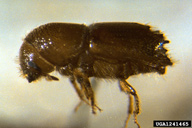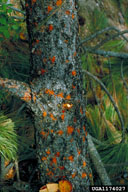“What’s Wrong With The Pine Trees?”
If you drive around Hernando County you will notice quite a few dead pine trees. This is because during spring and summer 2017 we had an outbreak of Ips pine engraver beetles (Ips sp.). It appears that the outbreak will continue this summer also. This beetle pest occurrence isn’t nearly as bad as the southern pine bark beetle, which can cause major losses of pine trees across the entire Southeast US; but if you are the one suffering the loss and expense of removing a dead pine tree, this is little comfort. The main areas in our county that have been affected are Spring Hill, WeekiWachee, areas west of US 19 and along Cortez Blvd., but there are pockets of beetle activity all across the county.
Tiny Beetles

Ladd Livingston, Idaho Department of Lands, Bugwood.org
There are three species of Ips beetles, along with turpentine beetle, native to Florida; and they all feed on stressed or damaged pine trees or trees that are growing too close to each other. These are very tiny insects, about the size of a grain of rice, and it is the grubs that damage the tree. Local pines were stressed by the drought we suffered during late winter/ early spring of last year. Some signs to look for on your pine trees are small holes in the bark, the presence of sawdust on the outer bark, and small balls of sap, or pitch tubes. If you peel the outer bark off of the trunk you will see small tunnels in the wood. The needles will all turn brown (usually very quickly) and hang on the tree. The bad news is that when the tree gets to this point, nothing can be done to save it. Often the seemingly healthy pines around this tree have also been attacked by beetles and they will be lost too.
Big Problems

All pine tree species growing in Hernando County are susceptible, but the most commonly affected is the sand pine (Pinus clausa). I have visited with several residents in neighborhoods affected by this outbreak and both trees in wooded lots and cared for trees in landscapes were equally attacked. There is no effective chemical control for these beetles. By the time beetle damage is noticed it is too late to save the tree. Preventative injections of insecticides do exist, but they must be performed before the tree is attacked and can be very expensive. These types of beetle outbreaks end with fall and cooler weather.
For more information on Ips Engraver Beetles: http://edis.ifas.ufl.edu/in701
How to tell if your pine tree has a problem with bark beetles: http://edis.ifas.ufl.edu/fr399
Featured image of dead pine trees by Edward L. Barnard, Florida Department of Agriculture and Consumer Services, Bugwood.org
 0
0
